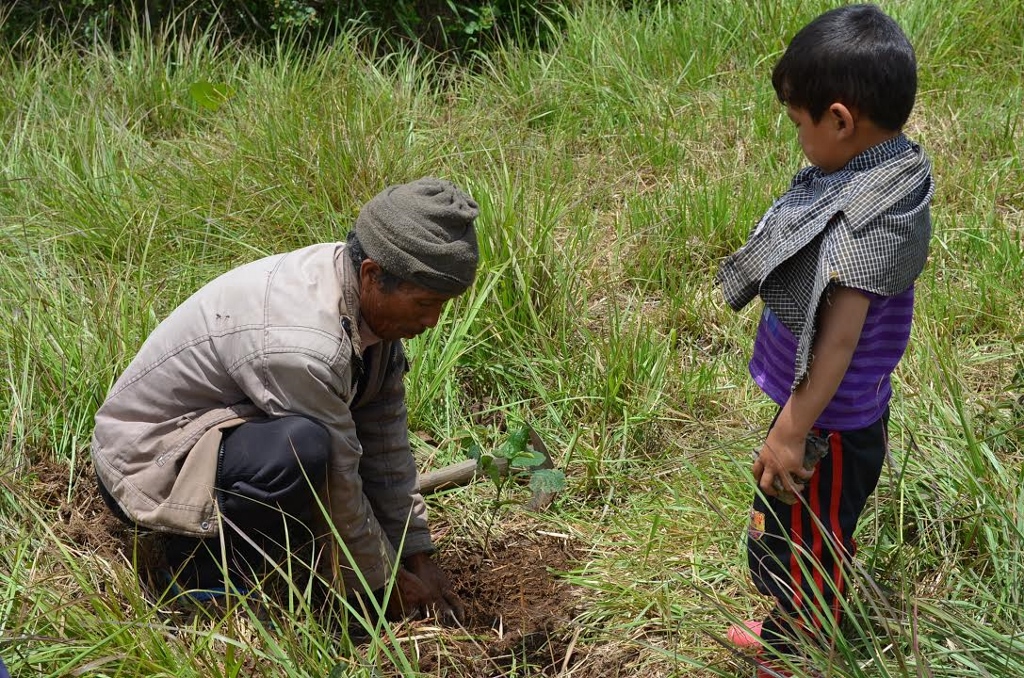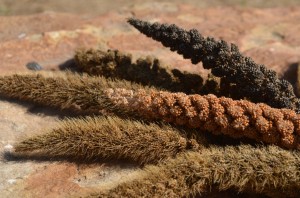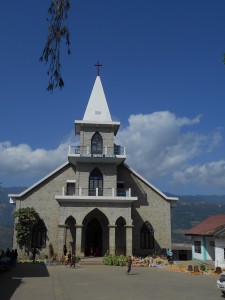
Photo: Raisa Daimary/NESFAS
The elders talk about a time that the forests were dense, fruit trees were abundant, the climate was cooler, the earth moist and fertile. As they widened their areas under cultivation the forests shrunk, limited only to uncultivable terrains, they took down more lumber for housing as the populations grew, the birds and animals went into hiding, the streams dried up as the hills became barren. Today, some of the trees are only seen deep in the forests. It didn’t take them too long to see the striking difference from just a few decades ago. This is a story of almost every other village of Meghalaya, not just some place in some other far of land.
They spoke amongst themselves and knew that something had gone wrong. Their realisation was echoed by others just like them – the 169 indigenous communities from around the world that were also present at the Indigenous Terra Madre, 2015 that took place in Shillong. Dialogues on various topics like challenges and achievements of indigenous communities, sustainable approaches towards conservation of biodiversity and culture, climate change, livelihoods and wellbeing, among other, during the eventlead them to realise their responsibility as indigenous people and protecters of biodiversity.
‘If you look at a map of global agrobiodiversity hotspots you soon realise that they are identical with indigenous people’s habitats…’Phrang Roy, co-ordinator of the Indigenous Partnership for Agrobiodiversity and Food Sovereignty and NESFAS, Chairman.
Biodiversity as a word and concept originated in the field of conservation biology. J B Alcorn, author of Indigenous Peoples and Conservations, states “…while proof of conservation success is ultimately biological, conservation itself is a social and political process, not a biological process. An assessment of conservation requires therefore an assessment of social and political institutions that contribute to, or threaten, conservation”. One of the main social aspects related to biodiversity is, undoubtedly, the case of the world’s indigenous peoples.
Indigenous peoples live in and have special claims to territories that, in many cases, harbour exceptionally high levels of biodiversity. On a global basis, human cultural diversity is associated with the remaining concentrations of biodiversity. Both cultural and biological diversity are endangered.
According to wikipedia, India is one of the richest countries in the world in terms of biodiversity which is also reflected in the demography of the land. Although the causes behind biodiversity and demographic diversity are different, the human population of the land has depended on the biodiversity in many ways for a long time. It cannot be ignored however, that the excessive human population of India has lead to pressures biodiversity. This would require to know and appreciate the diversity in both – human population and flora and fauna.
OF the 35 areas around the worldthat qualify as biodiversity hot spots, sites support nearly 60% of the world’s plant, bird, mammal, reptile, and amphibian species, with a very high share of endemic species, four regions that satisfy these criteria exist in India of which one lies in the Indo-burma region.
The Indo-Burma region encompasses several countries. It is spread out from Eastern Bangladesh to Malaysia and includes North-Eastern India south of Brahmaputra river, Myanmar, the southern part of China’s Yunnan province, Lao People’s Democratic Republic, Cambodia, Vietnam and Thailand. It is spread over 2 million sq. km of tropical Asia.
It is this understanding of their undeniable role as guardians of biodiversity which made the participant communities of ITM 2015 realise that they have to be more aware of the impact of the decisions they make in terms of use of their natural resources.
They decided that as their ancestors erected Monoliths, they would plant living Monuments – trees, that their children might see, and hopefully adopt, the values of preserving nature. It wasn’t going to be a random act but one with deeper understanding of how they could contribute to protecting their environment. On world Earth Day, the 22nd of April, the community met with NESFAS to talk about their plans in presence of Dr. Carl O. Rangad, former Director of Horticulture, Dept. of Agriculture, Meghalaya, and current Vice-Chairman, Operations, NESFAS and Dr. A.K Nongkynrih, Professor and HOD, Dept. of Sociology, NEHU. It was decided that based on traditional knowledge and biodynamic culture, the community would conduct a tree plantation drive on 4th of June, just a day before World Environment Day.
The area to be planted was surveyed and the types of trees to be planted were carefully decided on. A plot measuring up to 1.33 acres/5400 sq meters was later donated by the community for the plantation following testing of the density of soil and suitability. The community then dedicated time to identify and collect saplings of local trees for the plantation drive. Based on the calculation that a tree in this region would require roughly 7.07 sq. meters of covered area, the total number of trees required would be 764 trees or a minimum of 550 trees. While the community itself collected 150 saplings, the Nongtraw community of East Khasi Hills also showed its support by contributing 150 fruit plants. Another 200 and 350 were contributed by Dr. A. K. Nongkynrih, HOD and Professor of Sociology, North Eastern Hill University, and Dr. Rangad, respectively.
It wasn’t just the elders but youth and children as well who took part in the plantation with each of them planting a minimum of four plants each. The types of trees not just included alder trees which are known to be nitrogen fixing as well as medicinal but also timber, fruit and flowering trees from the surrounding areas.
Dr. Rangad guided the plantation with pointers about where the various types of trees should be planted. Deciduous trees were plantedat a distance from other trees as they will grow to be huge. Broad leaves were planted at the top of the hill for coverage,with Alder trees speckled in between, while fruit trees were planted at the bottom and sides of the hill so they can be easily accessed. He walked around checking if the trees were planted correctly to make sure each of the trees had a good chance of survival.
“I have never seen people coming out like this. There is a huge diversity here. In five years, the landscape is going to change and in 10 years, new springs will come up,” said Dr. Rangad. The community members too expressed their excitement. “This plantation is going to benefit my community. I know that my children will enjoy the benefits of our efforts and I look forward to a better future for them,” exclaimed Kong Levi Kharlyngdoh, Farmer and resident of Mawhiang. The children too seemed to understand the significance of the initiative. Damutskhem Kharwer, student, class 7, Roman Catholic Upper Primary School, Mawhiang, said, “I learned at school that plants produce oxygen and freshen our air. Today I planted a ‘sohphoh mawlyndaw’ tree. I will take care of my tree and if it dies I will plant another in its place.”
The plants will be looked after on a regular basis by the community as well as the individuals who will be responsible for the trees they planted. During the winter season, a survey will be conducted by NESFAS to see if the plants have survived and also collect and burn off the undergrowth not only to prevent uncontrolled forest fires ensuring that those that survived continue to.
While Mawhiang is only one village of Meghalaya, it is hoped that they will not only succeed in restoring and maintaining the biodiversity of their land but also stand out as an example not just to their future generations but other communities as well, locally and globally.
Mawhiang was one of the 41 villages representing Meghalaya at the event. They came back home knowing that they have to take steps towards restoring their land to how their elders found it.


